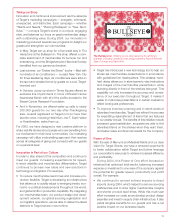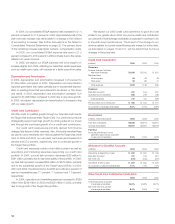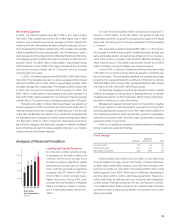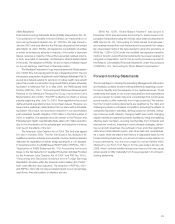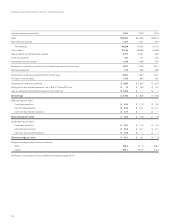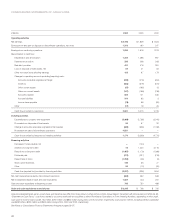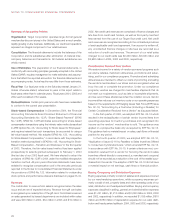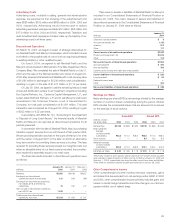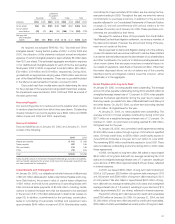Target 2004 Annual Report Download - page 24
Download and view the complete annual report
Please find page 24 of the 2004 Target annual report below. You can navigate through the pages in the report by either clicking on the pages listed below, or by using the keyword search tool below to find specific information within the annual report.
22
Allowance for doubtful accounts When receivables are recorded,
we recognize an allowance for doubtful accounts in an amount equal
to anticipated future write-offs. This allowance includes provisions for
uncollectible finance charges and other credit fees. We estimate future
write-offs based on delinquencies, risk scores, aging trends, industry
risk trends and our historical experience. Management believes that
the allowance for doubtful accounts is adequate to cover anticipated
losses in our credit card accounts receivable under current conditions;
however, significant deterioration in any of the factors mentioned
above or in general economic conditions could materially change
these expectations. Net accounts receivable and its related allowance
are described in the Notes to Consolidated Financial Statements on
page 30.
Analysis of assets for impairment We review assets at the lowest
level for which there are identifiable cash flows, which is usually at
the store level. The carrying amount of store assets is compared to
the expected undiscounted future cash flows to be generated by
those assets over the estimated remaining useful life of the store.
No impairments were recorded in 2004 or 2003 as a result of the
tests performed.
We evaluate goodwill for impairment on an annual basis or more
often if an event occurs or circumstances change that indicate
impairment might exist. Goodwill is evaluated for impairment through
the comparison of fair value of the related reporting unit to its carrying
value. No impairments were recorded in 2004, 2003 and 2002 as a
result of the tests performed. See further discussions in the Notes
to Consolidated Financial Statements on pages 30-31.
Pension and postretirement health care accounting We fund and
maintain a qualified defined-benefit pension plan and maintain certain
related non-qualified plans as well. Our pension costs are determined
based on actuarial calculations using key assumptions including our
expected long-term rate of return on qualified plan assets, the discount
rate and our estimate of future compensation increases. We also
maintain a postretirement health care plan for certain retired employees.
Postretirement health care costs are calculated based on actuarial
calculations using key assumptions, including the discount rate and
health care cost trend rates. Pension and postretirement health care
benefits are further described in the Notes to Consolidated Financial
Statements on pages 35-36.
Insurance/self-insurance We retain a portion of the risk related to
certain general liability, workers’ compensation, property loss and
employee medical and dental claims. Liabilities associated with these
losses include estimates of both claims filed and claims incurred but
not yet reported. We estimate our ultimate cost based upon analysis
of historical data and actuarial estimates. General liability and workers’
compensation liabilities are recorded at our estimate of their net
present value; other liabilities are not discounted. We believe the
amounts accrued are adequate, although our ultimate loss may differ
from the amounts provided. We maintain stop-loss coverage to limit
the exposure related to certain risks.
Income taxes We pay income taxes based on the tax statutes,
regulations and case law of the various jurisdictions in which we
operate. Our effective income tax rate from continuing operations was
37.8 percent, 37.8 percent and 38.2 percent in 2004, 2003 and 2002,
respectively. The income tax provision includes estimates for certain
unresolved matters in dispute with state and federal tax authorities.
Management believes the resolution of such disputes will not have a
material impact on our financial statements. Our effective income tax
rate in 2005 is expected to be approximately 37.5 to 38.1 percent.
Income taxes are further described in the Notes to Consolidated
Financial Statements on page 33.
New Accounting Pronouncements
2005 Adoptions
SFAS No. 151, “Inventory Costs, an amendment of ARB No. 43,
Chapter 4” was issued in November 2004 and is effective for fiscal
years beginning after June 15, 2005 with early adoption permitted.
SFAS No. 151 clarifies that abnormal amounts of idle facilities expense,
freight, handling costs and spoilage are to be recognized as current
period charges and provides guidance on the allocation of overhead.
We do not expect this statement to have an impact on our net earn-
ings, cash flows or financial position upon adoption.
SFAS No. 153, “Exchanges of Nonmonetary Assets – An
Amendment of APB Opinion No. 29,” was issued in December 2004
and is effective for nonmonetary asset exchanges occurring in fiscal
periods beginning after June 15, 2005 with earlier application permit-
ted. SFAS No. 153 addresses the measurement of exchanges of
nonmonetary assets. We do not expect this statement to have an
impact on our net earnings, cash flows or financial position upon
adoption.



